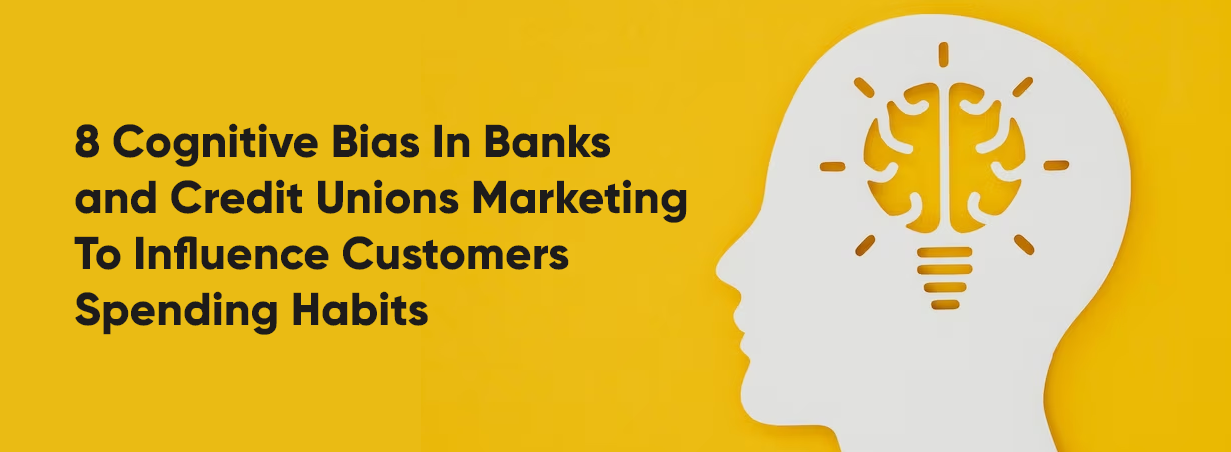8 Cognitive Bias In Banks and Credit Unions Marketing To Influence Customer’s Spending Habits
- Posted on March 22, 2023 by Robert
- Reading time about 5 minutes
In this age of digital marketing, influencing your customers and winning them is incredibly challenging for banks and credit card unions. Customers’ mail and message boxes are constantly bombarded with plenty of offers and promotional messages. Banks and credit unions have been known for their aggressive marketing tactics and their ability to convert customers into sales.
Cognitive bias – behavioral science of marketing can help in capturing the hearts and minds of customers. It improves the effectiveness of your marketing efforts by reinforcing buyers in their decision-making. Scalable customer loyalty and rewards management software brings cognitive bias in marketing and influences the customers spending behavior.
Cognitive Bias For Banks And Credit Unions
Banks and credit unions use cognitive bias as an umbrella to context and frame the promotional information to influence individuals’ judgment and attract customers with interactive offers and deals. They use the psychology of human thoughts and emotions with a cognitive bias to create a relationship of trust and loyalty with the customers.
Cognitive biases when integrated with the loyalty program for financial institutions can easily enhance everyday decision-making by tracking and analyzing human needs and demands. There are many kinds of cognitive biases that influence customers differently based on their characteristics and decision-making deviates from rational objectivity. Let us see some of the cognitive biases that are mostly used by banks and credit unions to enhance the loyalty and engagement of customers.
1. The Mere Exposure Effect
The mere exposure effect is used by banks and credit unions to increase the visibility and appearance of certain products and services. In this, when you deliver the same promotion regularly or daily, customers will accept it as it is prominent or popular to them. Banks and credit use product and service images in the banner in newsletter marketing. They also use social media to repeatedly tell their audience about the various advantages and features to market their product and services.
2. Anchoring Bias
When customers hear the same information regularly then they make a baseline for the decision-making or compare everything from that. Anchoring bias is used by banks and credit unions to deliver certain information that can define the decision-making or judgment of the customers. Thus, make a brand image among the customers and clearly define your product and services. Highlight your product and service while displaying your discount, top deals, and crossed-out information to bring more sales than the competitors.
3. The Framing Effect
The framing effect is used by banks and credit unions to market their products and services in an engaging and customer-centric way by explaining how it makes the user’s life better and delivers numerous benefits. Thus, illustrating diverse benefits and showing functioning rather than announcing its features draws different kinds of aspects in the customers buying behavior. The loyalty program for financial institutions plays a significant role in framing your offers of loyalty points, rewards, and rewards.
4. (FOMO) Fear Of Missing Out
This strategy is mostly used by marketers and promoters to show the availability of products and services for a limited time. Building a fear of missing important deals can help them to gain sales easily. Thus, building interest among the audience and influencing their spending on their products and services. Scalable customer loyalty and rewards management software create limited-time double-point campaigns to bring more sales.
5. Zeigarnik Effect
The Zeigarnik effect is a cognitive bias in which banks and credit unions show levels of their progress and encourage them to progress by showing them the next goal and reward for collected points. A Bank loyalty program allows you to curate levels and goals for the customers and creates a sense of unfinished business or a goal for customers. Customers feel that they will get more rewards and points when they complete all the levels.
6. The Ikea Effect
In this, banks and credit unions market their products and services by building emotional connections with the customers. They allow customers to be a part of their operations and make contributions to product development and other activities. Allow them to test certain products or features before launch or encourage them to leave product reviews on your site. This builds a level of trust among the audience. Thus, customers will love the experience and grow closer to your brand.
7. Priming Bias
The loyalty program for financial institutions allows banks and credit unions to stimulate the behavior of customers. It influences the individual’s behavior or thoughts and leverages this effect by using specific images, words, or symbols that are associated with a particular brand or type of spending. Delivering special rewards, such as access to airport lounges or concert tickets to prime customers to associate their cards with luxury and exclusivity can easily influence their spending behavior.
8. Bandwagon Effect
In this cognitive bias, banks and credit unions are likely to purchase products and services that are likely to be recommended and trusted by their peers and other audiences. This type of marketing strategy is more effective as customers tend to trust friends and family over corporate ads. The bank loyalty program allows customers social marketing by incorporating influencers and customers. They can share their views and experiences to align with your brand message. Organize contests on social media and reward customers with gifts, coupons, and points.
Conclusion
Banks and credit unions utilize a variety of cognitive biases to influence their customers and encourage them to spend more. Thus, they create a sense of urgency, increase customer engagement, and drive more transactions.
Do you want to enhance your customers’ engagement and spending habits of your customers? Novus loyalty program for financial institutions helps you in delivering scalable customer loyalty and rewards management software that can influence customers’ spending habits and align with your long-term financial goals and values.



